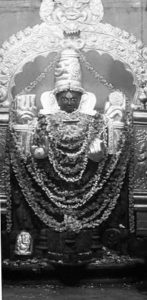Among those who built the Kannada Sahitya Parishad, it is essential for my contentment to reminisce about the early few. Nangapuram Venkatesha Iyengar is one of them. He was the chief of the government’s meteorological department. Apparently he was Bellave Venkatanaranappa’s teacher. Their affection and respect towards each other was intense. His contributions to the activities of the Vijñāna Pracāra Saṅgha run by Venkatanaranappa and to the publication of the newsletter Vijñāna were both wholehearted and invaluable. Nangapuram Venkatesha Iyengar was a person with liberal views about different faiths. He had an unsurpassed devotion towards Sri Ramakrishna Paramahamsa. He would be highly enthusiastic about the birthday celebrations of Ramakrishna and Vivekananda. If I remember right, he has even translated Sri Ramakrishna Paramahamsa’s Vacanāmṛta into Kannada. He has also written the biographies of great devotees including those of Nanda and Mirabai. He had a powerful writing style. It appears that during his student days, he had read with great interest a prose-poem, Saugandhikāpaharaṇa, composed in the campū-kāvya style. He was quite fond of the kāvya (poetical work) Jagannāthavijaya of Rudrabhaṭṭa. He was influenced by some of the greatest treatises of his time. Nangapuram Venkatesha Iyengar was an extremely honest man. He never tolerated dishonesty or injustice. He was not a man of many words. If the situation provoked him, the only words that would leave his lips were ‘Jāji’ (Jessamine), ‘Mallige’ (Jasmine), and ‘Sampige’ (Magnolia) or ‘Katti’ (knife, sword), ‘Pañju’ (torch), and ‘Śūla’ (spear). His temperament was singularly intense. He was as brutal as he was soft and as gentle as he was sharp. Whenever he attended Sāhitya Sammelanas (literary conferences), he carried a cane trunk filled with a variety of snacks like Pūri, Sajjappa, Chakkuli, Kaḍalekāyi uṇḍe, Yeḻḻuṇḍe, and Hurigāḻu. “Have you bathed?” he would ask our group of friends. Soon after our response in the affirmative, he would call us all to his room and distribute the snacks. In case we said, “That’s enough!” he would forcibly thrust a little more into our hands and say, “When you are asked to eat, you have to accept it!” And watching our mischief he would laugh.
One morning we landed in Harihara. Venkatesha Iyengar told Venkatanaranappa, “Oh! Today is Kārtika Somavāra![1] We’ve come to Harihara on quite an auspicious day indeed! We’ll need to perform an Ekādaśavāra Rudrābhiṣeka here and feed eleven brāhmaṇas.” In response Venkatanaranappa said, “Why not? We’ll do whatever is necessary.” We were ten people in our group. A man named Bhimasena Rao had come to the station for some personal work. Bowing in respect at the very sight of Venkatanaranappa, he said, “I am your student.” Recollecting him, “Yes. I’m glad to see you. May I seek a favour from you?” asked Venkatanaranappa. Bhimasena Rao was the Sub-Registrar of Harihara. “Yes, what can I do for you?” he asked. Handing him a five-rupee note Venkatanaranappa said, “Fine quality rice for two rupees, a rupee’s worth of milk, sugar for a rupee and a rupee’s worth of excellent quality ghee – these should be purchased and sent to the Travellers’ Bunglow. The rice should have been winnowed and cleaned. I will pay the labour charges. Apart from this, you will have to join us for lunch. Without you, we won’t have the eleven members we require.” With humility and reverence Bhimasena Rao accepted the mandate. However, it was Nangapuram Venkatesha Iyengar who played a crucial role in celebrating the ritual. With the fresh flow of water, the river (i.e. the Tungabhadra) had turned marshy with fine dust of red soil. Bathing in it and draped in wet clothes, Venkatesha Iyengar and Venkatanaranappa carried water in large vessels eight to ten times to the bungalow atop the hillock. They heated water and arranged for our bath at the bungalow. They brought water in another set of vessels and boiled it so that we could all have water to drink. Both of them were older than the rest of us. But we were quite headstrong; our shame had faded away. After placing a metal pot filled with water and performing the kalaśārcanā, if Venkatanaranappa, Togere Nanjundashastri, and Kadaba Nanjundashastri recited the Rudrasūkta[2] four times each, wouldn’t that give a total of twelve? After the Ekādaśavāra Rudrapāṭha,[3] the kalaśa was taken to the Harihareshvara temple and the deity was worshipped. After receiving the tīrtha and prasāda, we returned to the Travellers’ Bunglow by around one in the afternoon. Lunch had been arranged. Pickled mangoes, Potato and Brinjal Huḻi (Sambar), Boṇḍa, Hesarubeḻe pāyasa (Kheer made from Moong Daal), fresh buttermilk – all this. The meal was delectable. Vegetables, a bit of rice and lentils, pickles, ghee, and spices would always be stored in Venkatanaranappa’s circuit box. He largely adhered to the traditional discipline of cooking for oneself.
This is an English translation of the eleventh chapter of D V Gundappa’s Jnapakachitrashaale – Vol. 3 – Sahityopasakaru. Edited by Hari Ravikumar.
Footnotes
[1] An auspicious Monday during the lunar month Kārtika (typically mid-October to mid-November).
[2] A renowned poem in praise of the deity Rudra from the Taittirīya-saṃhitā (Kṛṣṇa-yajurveda); it is also called the rudra-praśna.
[3] The rudrasukta is repeated in multiples of eleven because there are eleven rudras (storm deities).















































